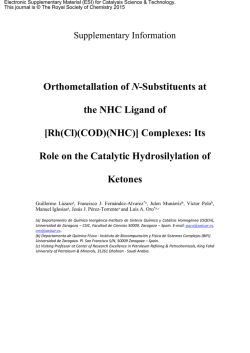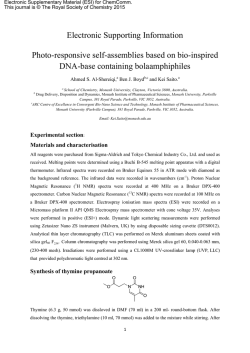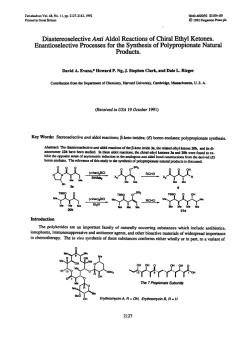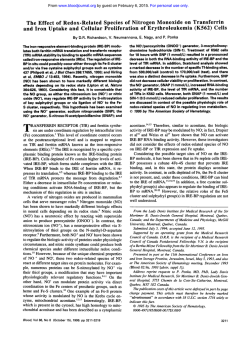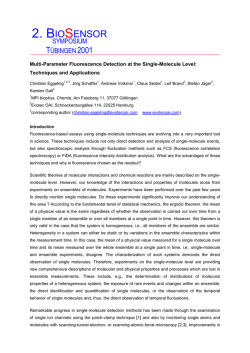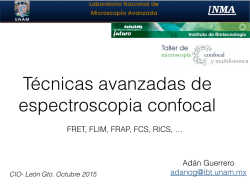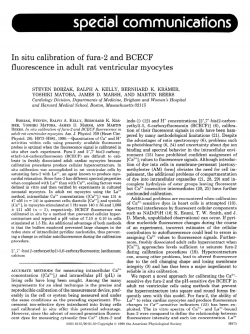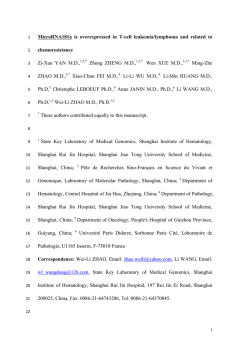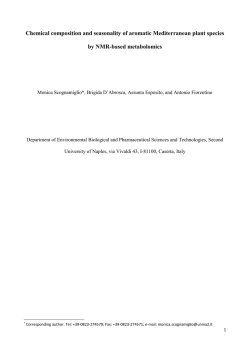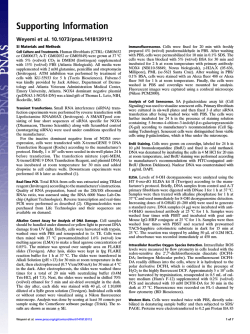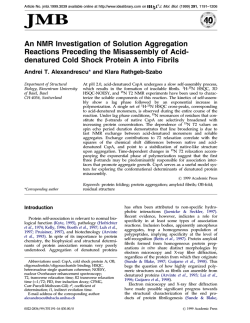
Supporting Information Rapid Probing of Sialylated Glycoproteins in
Electronic Supplementary Material (ESI) for Organic & Biomolecular Chemistry. This journal is © The Royal Society of Chemistry 2015 Supporting Information Rapid Probing of Sialylated Glycoproteins in vitro and in vivo via Metabolic Oligosaccharide Engineering of Minimal Cyclopropene Reporter De-Cai Xiong,a Jingjing Zhu,a,b Ming-Jie Han,a Hui-Xin Luo,a Cong Wang,a Yang Yu,a Yuqian Ye,a Guihua Tai,b and Xin-Shan Yea,* a State Key Laboratory of Natural and Biomimetic Drugs, School of Pharmaceutical Sciences, Peking University, Xue Yuan Road No. 38, Beijing 100191, China b School of Life Sciences, Northeast Normal University, Changchun 130024, China E-mail: [email protected] S0 Contents Supplementary Figure Index ...........................................................S2 General Methods ...............................................................................S3 Chemical Synthesis ............................................................................S3 Kinetic Measurements.........................................................................S9 Bioassay............................................................................................... S13 HPLC Analysis of DMB-derivated SiaNCp.......................................S25 NMR Spectra .......................................................................................S36 References............................................................................................ S44 S1 Supplementary Figure Index Figure No. Figure Name Page Fig. S1 Stability of cyclopropene derivative 3 in the presence of L-cysteine S9 Fig. S2 Kinetic Measurements S10 “Turn on” fluorescence of tetrazine-fluorophore 14 upon reaction with cyclopropene Fig. S3 S12 derivative 3. Metabolism of Ac4ManNCp and ligation with FITC-Tz, TAMRA-Tz or TAMRA in HL-60 Fig. S4 S16 cells The fluorescence of Ac4ManNCp-treated cells is dependent upon the concentration of S17 Fig. S5 FITC-Tz and time course of the cell-surface ligation reaction Fig. S6 Metabolism of Ac4ManNCp in various cell lines S18 Fig. S7 The proliferation effect of Ac4ManNCp on four kinds of cell lines S19 Fig. S8 Effects of tunicamycin or αBnGalNAc on Ac4ManNCp metabolism S20 Fig. S9 Effects of Ac4ManNAz or Ac4ManNAc on Ac4ManNCp metabolism S21 Fig. S10 Comparison between Ac4ManNCp and Ac4ManNMCp in Metabolism activity S22 The comparison of metabolic capacity of Ac4ManNCp (Cp), Ac4ManNMCp (MCp) and S24 Fig. S11 Ac4ManNAz (Az) Fig. S12 HPLC traces of derivatized-DMB-SiaNCp from Jurkat cells S26 Fig. S13 LC-IT-TOF analysis of standard for derivatized-DMB-SiaNCp S27 Fig. S14 HPLC traces of DMB-SiaNMCp from Jurkat cells S28 Fig. S15 HPLC traces of DMB-SiaNAz from Jurkat cells S29 Fig. S16 HPLC traces of derivatized-DMB-SiaNCp from Hela. S30 Fig. S17 HPLC traces of DMB-SiaNMCp from Hela S31 Fig. S18 HPLC traces of DMB-SiaNAz from Hela S32 Fig. S19 HPLC traces of derivatized-DMB-SiaNCp from MCF7 S33 Fig. S20 HPLC traces of DMB-SiaNMCp from MCF7 S34 Fig. S21 HPLC traces of DMB-SiaNAz from MCF7 S35 S2 General Methods All chemicals were purchased as reagent grade and used without further purification. Reactions were monitored by analytical thin-layer chromatography on silica gel 60 F254 precoated on aluminium plates. Spots were detected under UV light and/or by staining with acidic ceric ammonium molybdate. Column chromatography was performed on silica gel (200―300 mesh). Nuclear magnetic resonance (NMR) spectra were recorded at room temperature on Avance III 400 and Avance III 600 instruments from Bruker. Chemical shifts are referenced to an internal SiMe4 standard or to residual solvent protons. The following standard abbreviations are used to indicate multiplicity: s = singlet, d = doublet, t = triplet, q = quartet, m = multiplet, dd = doublet of doublets, dt = doublet of triplets, and br = broad. Mass spectra were recorded using a Bruker APEX IV FTMS spectrometer. Preparative high performance liquid chromatography (HPLC) runs were conducted on a HPLC-2535 with UV-Vis Detector from Waters. Analytical HPLC runs were conducted on an Alliance e2695 with Waters 2475 Multi λ Fluorescence Detector, and performed using a SunfireTM c18, 3.5 μm, 4.6 x 150 mm column. LC-MS runs were conducted on a Shimadzu LCMS-IT-TOF using Thermo BateBasic-18 column. Chemical Synthesis Succinimidyl cycloprop-2-ene-1-ylcarboxylate (2) O O O N 2 O To a stirred solution of ethyl cycloprop-2-ene-1-yl carboxylate (1) 1 (3.36 g, 30.0 mmol) in THF/MeOH (3:1) (60 mL/20 mL) at 0 oC was added LiOH aq. (2.16 g of LiOH in 20 mL of water, 90 mmol) dropwise, and the homogeneous yellow mixture was allowed to stir overnight under N2 atmosphere. The progress of the reaction was monitored periodically by TLC analysis to ensure that the hydrolysis was complete. The mixture was then concentrated on the rotary evaporator (at room temperature) to remove the organic solvents. To the resulting aqueous solution was S3 added ethyl acetate (300 mL), and the mixture was cooled by an ice bath. Aqueous HCl solution (6 M) was added dropwise until the aqueous phase was rendered acidic (pH ∼3). The aqueous layer was extracted twice with portions of ethyl acetate (300 mL). The combined organics were dried over Na2SO4, filtered, and concentrated. The residue was dissolved in ethyl acetate/1,4-dioxane (60 mL/60 mL). Then, N-hydroxysuccinimide (NHS, 2.46 g, 24.1 mmol, 1.05 eq.) and N,N'-dicyclohexylcarbodiimide (DCC, 4.40 g, 21.4 mmol, 1.05 eq.) were added to the resulting solution and stirred overnight. The reaction mixture was filtered and the filtrate was concentrated. The crude product was purified by flash column chromatography on silica gel (petroleum ether/ ethyl acetate = 1.5/1, monitored by TLC, stained by KMnO4) to afford compound 2 (2.50 g, 46% yield over two steps) as a white solid. 1 H NMR (CDCl3, 400 MHz): δ 6.98 (d, J= 1.2 Hz, 2H,), 2.81 (br, 4H), 2.46 (t, J = 1.2 Hz, 1H); 13 C NMR (CDCl3, 100 MHz): δ 170.75, 169.21, 102.24, 25.57, 14.36; HRMS (ESI) Calculated for C8H7NO4Na [M+Na]+: 204.0267, Found: 204.0273. N-(Cycloprop-2-ene-1-ylcarbonyl)-N’-(tert-butyloxycarbonyl)-1,2-ethylenediami ne (3) O NHBoc NH 3 To a stirred solution of H2NCH2CH2NHBoc (116.0 mg, 0.725 mmol, 1 eq.) and DIPEA (229.6 mg, 1.59 mmol,2.2 eq.) in DMF (3.6 mL), a solution of compound 2 (131.2 mg in 1.5 mL of DMF, 0.725 mmol, 1 eq.) was added dropwise at room temperature. The resulting solution was allowed to stir overnight under N2 atmosphere. The solvent was removed at room temperature under reduced pressure, and the crude product was purified by flash column chromatography on silica gel (petroleum ether/acetone = 1/1) to afford compound 3 (85.2 mg, 52% yield) as a white solid. S4 1 H NMR (CD3OD, 400 MHz) δ 7.16 (s, 2H), 3.31-3.24 (m, 2H), 3.16 (t, J= 6.0 Hz, 2H), 2.09 (s, 1H), 1.46 (s, 9H); 13 C NMR (CD3OD, 100 MHz): δ 179.29, 158.63, 105.56, 80.14, 41.09, 40.78, 28.73, 18.95. HRMS (ESI) Calculated for C11H18N2O3Na [M + Na]+: 249.1210, Found: 249.1198. N-(2-Methylcycloprop-2-ene-1-ylcarbonyl)-N’-(tert-butyloxycarbonyl)-1,2-ethyle nediamine (5) O NHBoc NH 5 To a stirred solution of H2NCH2CH2NHBoc (190.4 mg, 1.19 mmol, 1 eq.) and DIPEA (375.8 mg, 2.61 mmol,2.2 eq.) in DMF (6.0 mL), a solution of succinimidyl 2-methylcycloprop-2-ene-1-ylcarboxylate (4), 2 (231.7 mg in 2.4 mL of DMF, 1.19 mmol,1 eq.) was added dropwise at room temperature. The resulting solution was allowed to stir overnight under N2 atmosphere. The solvent was removed at room temperature under reduced pressure, and the crude product was purified by flash column chromatography on silica gel (petroleum ether/acetone = 1/1) to afford compound 5 (265.0 mg, 93% yield) as a white solid. 1 H NMR (CD3OD, 400 MHz): δ 6.52 (t, J = 1.2 Hz, 1H), 3.27-3.24 (m, 2H), 3.13 (t, J = 6.0 Hz, 2H), 2.14 (d, J = 1.2 Hz, 3H), 2.00 (d, J = 1.6 Hz, 1H), 1.44 (s, 9H); 13 C NMR (CD3OD, 100 MHz): δ 179.60, 158.64, 114.11, 96.50, 80.13, 41.17, 40.70, 28.76, 22.78, 10.43; HRMS (ESI) Calculated for C12H20N2O3Na [M + Na]+: 263.1372, Found: 263.1373. The synthesis of compound 7 S5 O O H N N H O N N N N 7 To a stirred solution of compound 3 (11.0 mg, 0.5 mmol, 1eq.) in H2O/MeOH (2.5 mL/2.5 mL) at room temperature was added 6 (23.6 mg, 1.0 mmol, 2 eq.). After stirring for 30 min at room temperature the solvents were evaporated under reduced pressure. The residue was dissolved in EtOAc (100 mL) and washed with H2O (20 mL), sat. NaCl solution (20 mL). The organic layer was dried over Na2SO4. After filtration, the solution was evaporated. The residue was purified by column chromatography on silica gel (DCM/MeOH: 80/1 to 30/1) to afford compound 7 (15.0 mg, 71% yield) as a light yellow solid. 1 H NMR (400 MHz, DMSO-d6) δ 8.79 (br.s, 2H), 8.37 (d, J = 7.2 Hz, 2H), 8.27 (br.s, 1H), 7.99 (t, J = 6.8 Hz, 2H), 7.60 (br.s, 2H), 6.85 (br.s, 1H), 3.68 (s, 2H), 3.19 (d, J = 5.2 Hz, 2H), 3.00 (d, J = 4.8 Hz, 2H), 1.33 (s, 9H), 1.25 (s, 1H); 13 C NMR (DMSO-d6, 100 MHz): δ 169.37, 160.17, 155.58, 153.19, 149.48, 137.12, 125.38, 121.31, 77.68, 28.16, 24.61, 20.37. HRMS (ESI) Calculated for C23H27N6O3 [M + H]+: 435.2139, Found: 435.2147. 1,3,4,6-Tetra-O-acetyl-2-N-(cycloprop-2-ene-1-ylcarbonyl)-D-mannosamine (10) To a stirred solution of D-mannosamine hydrochloride (50.0 mg, 0.232 mmol) in MeOH (4.0 mL) at room temperature was added NaOMe (13.8 mg, 0.255 mmol). The reaction mixture was stirred for 1 h. Compound 2 (63.0 mg, 0.348 mmol) was added to the mixture and stirred for 48 h at room temperature. The solvent was evaporated and the residue was purified by flash column chromatography on silica gel (CH2Cl2: MeOH = 2:1, monitored by TLC, stained by KMnO4) to give the ManNCp. Then, ManNCp was dissolved in pyridine (3.0 mL), Ac2O (0.60 mL) was added to the solution at 0 oC and stirred for 2 h at room temperature. The solvent was evaporated and the residue was subjected to flash column chromatography on silica gel S6 (petroleum ether: acetone = 2:1, monitored by TLC) to give the crude product 10. Further purification of Ac4ManNCp (10) (24.0 mg, 25% yield) was performed by using preparative high performance liquid chromatography. For α-isomer: 1H NMR (600 MHz, CDCl3) δ 7.05 (d, J = 0.6 Hz, 1H), 7.02 (d, J = 0.6 Hz, 1H), 6.01 (d, J = 1.8 Hz, 1H), 5.68 (d, J = 9.6 Hz, 1H), 5.33 (dd, J = 4.2, 10.2 Hz, 1H), 5.17 (t, J = 10.2 Hz, 1H), 4.67 (ddd, J = 1.8, 4.2, 10.2 Hz, 1H), 4.26 (dd, J = 4.2, 12.6 Hz, 1H), 4.07 (dd, J = 2.4, 12.6 Hz, 1H), 4.04 (ddd, J = 2.4, 4.2, 10.2 Hz, 1H), 2.18 (s, 3H), 2.16 (t, J = 1.2 Hz, 1H), 2.11 (s, 3H), 2.07 (s, 3H), 2.00 (s, 3H). 13C NMR (150 MHz, CDCl3) δ 175.52, 170.46, 170.07, 169.69, 168.16, 105.19, 105.00, 91.76, 70.09, 68.89, 65.37, 61.99, 49.26, 20.85, 20.74, 20.71, 20.66, 19.10. HRMS (ESI) Calculated for C18H23NO10Na [M + Na]+: 436.1214, Found: 436.1206. For β-isomer: 1H NMR (600 MHz, CDCl3) δ 7.07 (s, 1H), 7.04 (s, 1H), 5.86 (d, J = 1.6 Hz, 1H), 5.80 (d, J = 9.2 Hz, 1H), 5.12 (t, J = 9.6 Hz, 1H), 5.04 (dd, J = 4.0, 10.0 Hz, 1H), 4.77-4.81 (m, 1H), 4.28 (dd, J = 5.2, 12.4 Hz, 1H), 4.12 (dd, J = 2.4, 12.1 Hz, 1H), 3.80 (ddd, J = 2.4, 4.4, 9.2 Hz, 1H), 2.17-2.18 (m, 4H), 2.11 (s, 3H), 2.07 (s, 3H), 2.00 (s, 3H). 13 C NMR (150 MHz, CDCl3) δ 176.09, 170.44, 170.11, 169.69, 168.36, 105.32, 105.16, 91.68, 73.39, 71.42, 65.25, 61.90, 49.57, 29.68, 20.78, 20.70, 20.67, 19.19. HRMS (ESI) Calculated for C18H23NO10K [M + K]+: 452.0956, Found: 452.0954. The synthesis of TAMRA-Tz (14) N N O N N O O O NHS, DCC, DMF DIPEA, DMF O O N O 14-1 H2NCH2(CH2)4COOH O O 14-3 14-2 O HN CH2(CH2)4COOH O O N N O N N N O 14-4 H N O O N NH2 Me2N NMe2 O NH 14-5 N N DIPEA, DMF O O O O O O N HN O S7 N N HN N NH O O 14 N N N To a solution of the succinimidyl ester 14-1 (10.0 mg, 20 µmol, 1.0 eq.) in anhydrous DMF (1.5 mL), 6-aminohexanoic acid (14-2) (3.94 mg in 1.0 mL of DMF, 30 µmol, 1.5 eq.) and N,N-diisopropylethylamine (5.69 mg, 7.6 µL, 44 µmol,2.2 eq.) were added and the reaction mixture was stirred in the dark for 12 h. The solvent was evaporated and the residue was dried under vacuum. The product was purified by preparative HPLC using a gradient from 10% to 90% of buffer B in buffer A (buffer A: H2O, 0.1% TFA; buffer B: acetonitrile, 0.1% TFA), yielding 14-3 (Identified by MAIDL-TOF, [M+H]+ 544.18 (Calcd. 544.24)). To a solution of 14-3 (10.0 mg, 0.018 mmol, 1.0 eq.) and N-hydroxysuccinimide (2.28 mg, 0.0198 mmol, 1.1 eq) in DMF (1.0 mL), dicyclohexylcarbodiimide (DCC, 11.13 mg, 0.054 mmol, 3.0 eq) was added. After stirring at room temperature for 24 h, the mixture was concentrated under reduced pressure. The residue was purified by C-18 reverse phase chromatography to afford succinimidyl ester 14-4 (Identified by MALDI-TOF, [M+H]+ 641.50 (Calcd. 641.25)). Compound 14-4 was dissolved in anhydrous DMF (1.0 mL). The resulting solution was added 14-5 3 (11.1 mg, 0.036 mmol, 2.0 eq.) and N,N-diisopropylethylamine (6.98 mg, 9.34 µL, 0.054 mmol, 3.0 eq.). The reaction mixture was stirred in the dark for 12 h. The solvent was evaporated and the residue was dried under vacuum. The product was purified by preparative HPLC using a gradient from 20% to 90% of buffer B in buffer A (buffer A: H2O, 0.1% TFA; buffer B: acetonitrile, 0.1% TFA), to give the desired 14 (Identified by MAIDL-TOF, [M+H]+ 836.78 (Calcd. 836.36)). The synthesis of FITC-Tz (15) HO O HO OH O O O N N N N NH N N 14-5 NH2 S C N 15-1 HN O N N N N S NH N N DIPEA, DMF O NH 15 O OH O Compound 14-5 (3.9 mg, 10 µmol, 1.0 eq.) was dissolved in anhydrous DMF (1.0 mL). The resulting solution was added 15-1 (4.0 mg, 13 µmol, 1.3 eq) and S8 N,N-diisopropylethylamine (3.8 mg, 30 µmol, 3.0 eq.). The reaction mixture was stirred in the dark for 12 h. The solvent was evaporated and the residue was dried under vacuum. The product was purified by preparative HPLC using a gradient from 10% to 70% of buffer B in buffer A (buffer A: H2O, 0.1% TFA; buffer B: acetonitrile, 0.1% TFA), affording product 15 (Identified by MAIDL-TOF, [M+H]+ 698.99 (Calcd. 698.69)). Figure S1. Stability of cyclopropene derivative 3 in the presence of L-cysteine. Compound 3 was combined with 2.0 equivalent of L-cysteine in CD3OD/D2O (1/1) and kept at room temperature. 1H NMR was taken at 0 h, 24 h, 72 h. Kinetic Measurements Kinetic measurements were carried out under second order conditions. 4 Experiment was done with 2.0 mM tetrazine 6 and increasing excess of cyclopropene 3 or 5 in a quartz cuvette at 25 °C. To monitor the reaction over time, the change in tetrazine S9 absorbance at 525 nm was measured (every 2 or 10 seconds). The absorption at 525 nm corresponds to the concentration of tetrazine 6. The corresponding observed reaction rates (kobs) were determined by plotting 1/[tetrazine] versus time, followed by analysis by linear regression (the left graph of Figures S2B and S2C). The corresponding observed reaction rates plotted against 3 or 5 concentrations. The slope of the resulting line was used to determine the second-order rate constant (the right graph of Figures S2B and S2C). Data fits were performed with OriginPro 8.0. S10 Figure S2. Kinetic measurements. (A) UV/Vis Absorption spectra of the compounds 3, 5, 6, 7, 8. The absorption at 525 nm corresponds to the concentration of cycloaddition products 7 and 8; (B) Kinetics of the tetrazine 6 reaction with cyclopropene 3 at 25 °C. Experiment was done with 2.0 mM tetrazine 6 and increasing excess of cyclopropene 3: 10.0 mM (black), 20.0 mM (red), 30.0 mM (blue) , and the absorbance was recorded every 10 seconds; (C) Kinetics of the tetrazine 6 reaction with cyclopropene 5 at 25 °C. Experiment was done with 2.0 mM tetrazine 6 and increasing excess of cyclopropene 5: 20.0 mM (black), 30.0 mM (red), 40.0 mM (blue), and the absorbance was recorded every 10 seconds. S11 Figure S3. “Turn on” fluorescence of tetrazine-fluorophore 14 upon reaction with cyclopropene substrate 3. S12 Bioassay Cell culture. Jurkat, HL-60, MDA-MB-231, MDA-MB-435, MCF-7, HCT116, Hela, HEK 293T cell lines were obtained from cell culture center of Institute of Basic Medical Sciences, Chinese Academy of Medical Sciences (Beijing, China). Jurkat, HL-60 were cultured in RPMI-1640 medium containing 10% (v/v) fetal bovine serum, 100 U/mL of benzyl penicillin and 100 μg/mL of streptomycin. MDA-MB-231, MDA-MB-435, HCT116, Hela, HEK 293T, MCF-7 were cultured in DMEM medium containing 10% (v/v) fetal bovine serum, 100 U/mL of benzyl penicillin and 100 μg/mL of streptomycin. All cells were incubated in a humidified incubator at 37 °C with 5% CO2. Labelling of cell-surface using cyclopropene or methyl-cyclopropene group. Suspension cells were seeded in 6-well culture plates at a density of 1.5×105 cells/mL, supplied without or with Ac4ManNCp or Ac4ManNMCp at indicated concentration in a total volume of 3 mL of culture medium. After 2 or 3 days incubation, the cells were harvested with Eppendorf tubes, pelleted (2000 rpm, 4 min), washed with 1 mL of labelling buffer (3% FBS in RPMI-1640) for 3 times. Then, the cells were counted at the density of 2×106/mL with 0.1 mL, labelled with 0.1 mL of FITC-Tz or TAMRA-Tz at final concentration of 10 μM or 100 μM for 1 h (2 h for comparison with Ac4ManNMCp ) at 37 oC, followed by stained with 1μg/mL of Hoechst 33342 for 10 min at 37 oC. The cells were pelleted, washed 3 times with 1 mL of cold labelling buffer and then analyzed by flow cytometry (Guava 5.3, Millipore) and taken photos with fluorescence microscope (ZEISS, Germany). For adherent cells, the cells were seeded in 24-well culture plates at a density of 2×104 cells/mL. After 24 h incubation, the cells were supplied without or with Ac4ManNCp or Ac4ManNMCp at indicated concentration in a total volume of 0.75 mL of culture medium for 2 or 3 days. The cells were washed, labelled with FITC-Tz, stained with Hoechst 33342 and then digested with 0.02% EDTA solution. After S13 washing, the fluorescence signal of the cells was measured by flow cytometry and fluorescence microscope. Inhibition studies. Jurkat or HL-60 cells were seeded in 6-well culture plates at a density of 1.5×105 cells/mL, supplied without or with 20 μM of Ac4ManNCp, added the desired amount of inhibitor tunicamycin (0.5, 1, 5 μg/mL) or αBnGalNAc (0.5-3 mM) at the same time in a total volume of 3 mL of culture medium. Jurkat cells were used to evaluate the inhibition of Ac4ManNAz or Ac4ManNAc (10-80 μM). The cells were incubated for 3 days. Control wells were also seeded with cells, containing 20 μM of Ac4ManNCp alone. Western blot analysis. The cells (Jurkat, HEK 293T, CHO, Hela, MCF-7) were seeded in 6-well culture plates at a density of 1×105 cells/mL, supplied without or with Ac4ManNCp, Ac4ManNMCp or Ac4ManNAz (50 μM) in a total volume of 3 mL of culture medium. After 3 days incubuation, the cells were harvested and pelleted (2000 rpm, 4 min), washed with PBS for 3 times, and then the cells were lysed with 100 μL of lysis buffer (1% Igepal™ CA-630, 150 mM of NaCl, 50 mM of triethanolamine, pH 7.4) on ice for 30 min. The lysates were pelleted (16,000 g, 10 min, 4 °C) and protein concentrations were measured using a BCA protein assay kit (Thermo). Lysates (~1 mg/mL, 100 μL) were treated with either Tz-biotin (100 μM, 1 h, 37 °C) or freshly prepared "click" chemistry cocktail (1 h, 37 °C) containing alkyne-biotin (100 μM), sodium tris[(1-benzyl-1-H-1,2,3-triazol-4-yl)methyl]amine ascorbate (TBTA) (1 (100 μM), mM), and CuSO4•5H2O (1 mM). To precipitate the labelled proteins, ice-cold methanol (1 mL) was added and the samples were stored at -80 °C overnight. The protein precipitates were pelleted (16,000 g, 10 min, 4 °C) and dried at room temperature. The protein pellets were then re-suspended in 20 μL of buffer (4% SDS, 150 mM of NaCl, 50 mM of triethanolamine, pH 7.4), and then treated with 2X SDS-PAGE loading buffer (20 μL). The samples were heated at 95 °C for 5 min, separated by SDS-PAGE, and then transferred to PVDF membranes (0.2 μm; Milipore). The membranes were washed 3 times with TBST buffer and incubated with blocking buffer (5% bovine serum S14 albumin in TBST) for 1 h at room temperature, followed by HRP- streptavadin (1:5,000 dilution in blocking buffer) for 1 h. The membranes were subsequently washed with TBST (5 x 10 min) and imaged using the ChemiDoc XRS automatic photomicro-graph system (Bio-Rad, USA). Western bolt was also used to detect the murine organs (heart, liver, kidney) metabolism. The isolated organs were homogenized in 2 mL of lysis buffer (50 mM of Tris, 150 mM of NaCl, 1% NP-40, 0.5% sodium deoxycholate, 0.1% SDS, pH=7.4). After being measured the concentration, the lysates (~2 mg/mL, 100 μL) were treated with Tz-biotin (100 μM, 1 h, 37 °C) and then analyzed by western blot. HPLC analysis of DMB-derivated SiaNCp. Cells were cultured in 60 mm culture dishes and incubated without or with Ac4ManNCp, Ac4ManNMCp or Ac4ManNAz (20 μM or 100 μM). After 3 days incubuation, the cells were harvested and protein precipitates were prepared as mentioned above. 2 M acetic acid (100 μL) was added for the protein samples to release sialic acids at 80 oC for 2 h. The samples were cooled to room temperature and then incubated with 80 μL of DMB solution (7 mM DMB, 0.75 M β-mercaptoethanol, 18 mM Na2S2O4, 1.4 M acetic acid) at 50 oC for 2 h. After the incubation, 10 μL of 0.2 M NaOH were added to quench the reaction. Then, the samples were filtered in 3 KD MWCO filters by centrifugation and the flow containing DMB derivatives was collected. The fluorescent, DMB-derivatized sialic acids were analyzed on an Alliance e2695-4 HPLC with the Waters 2475 Multi λ Fluorescence Detector, using SunfireTM c18, 3.5 μm, 4.6 x 150 mm column. The fluorophore was excited at 373 nm and the emission detected at 448 nm, respectively. The DMB-derivatized sialic acids were identified and quantified by comparing elution times and peak areas to the known standards. Metabolism of Ac4ManNCp in vivo. C57BL/6 mice were administered Ac4ManNCp (300 mg/kg in 200 μL of 60% DMSO in PBS) or vehicle (200 μL of 60% DMSO in PBS) intraperitoneally once time. After 12 h, the mice were killed by cervical dislocation and their splenocytes were isolated using a standard protocol. Followed by labelling with 100 μM of FITC-Tz and staining with 1 μg/mL of Hoechst 33342, the S15 fluorescence signal of the cells was measured by flow cytometry and fluorescence microscope. Figure S4. Metabolism of Ac4ManNCp and ligation with FITC-Tz, TAMRA-Tz or TAMRA in HL-60 cells. HL-60 cells were incubated without or with 20 μM of Ac4ManNCp for 3 days, washed, and stained with 100 μM of FITC-Tz (A), TAMRA-Tz (B) or TAMRA (C) for 1 h at 37 C, then stained with 1 μg/mL of Hochest 33342 for 10 min. After washing, the cells were taken o photos by fluorescence microscope. S16 Figure S5. The fluorescence of Ac4ManNCp-treated cells is dependent upon the concentration of FITC-Tz and time course of the cell-surface ligation reaction, as monitored by flow cytometry. HL-60 cells were incubated in the presence or absence of 20 μM of Ac4ManNCp for 3 days, washed and treated with different concentration of FITC-Tz for various time periods at 37 oC. The cells were washed again and monitored by flow cytometry. The fluorescence signal obtained from flow cytometry is reported in arbitrary units and error bars represent the standard deviation for three replicate data points. S17 Figure S6. Metabolism of Ac4ManNCp in various cell lines. Cell lines were incubated without or with different concentrations of Ac4ManNCp for 3 days, washed, and treated with 10 μM or 100 μM of FITC-Tz for 1 h at 37 oC. After washed, the fluorescence signal was measured by flow cytometry. S18 Figure S7. The proliferation effect of Ac4ManNCp on four kinds of cell lines. The cells were treated with 100 μM of Ac4ManNCp for 72 h. The anti-proliferative effects of Ac4ManNCp were determined by the CCK-8 assay. The data are shown as mean ± SD of three independent experiments. S19 Figure S8. Effects of tunicamycin or αBnGalNAc on Ac4ManNCp metabolism. Cells were incubated without or with 20 μM of Ac4ManNCp and various amounts of tunicamycin (A, B) or αBnGalNAc (C, D) for 3 days, washed, and stained with 100 μM of FITC-Tz for 1 h at 37 oC. The fluorescence signal was measured by flow cytometry. S20 Figure S9. Effects of Ac4ManNAz or Ac4ManNAc on Ac4ManNCp metabolism. Jurkat cells were incubated with 20 μM of Ac4ManNCp and various amounts of Ac4ManNAz or Ac4ManNAc for 3 days, washed, and stained with 100 μM of FITC-Tz for 1 h at 37 oC. The fluorescence signal measured by flow cytometry is reported as percent of control, where the control represents the fluorescence signal from Jurkat cells incubated with 20 μM of Ac4ManNCp alone. S21 S22 Figure S10. The comparison between Ac4ManNCp and Ac4ManNMCp in metabolism activity. (A) Cells were incubated without or with indicated concentration of Ac4ManNCp or Ac4ManNMCp for 48 h, washed, and treated with 100 μM of FITC-Tz for 2 h at 37 oC. The fluorescence signal was measured by flow cytometry. (B) The comparison of fluorescence signal of 20 μM of Ac4ManNCp or Ac4ManNMCp was reported in fold units as mean ± SD of three replicates. (C) The fluorescence signal of 20 μM of Ac4ManNCp or Ac4ManNMCp was measured by fluorescence microscope. S23 Figure S11. The comparison of metabolic capacity of Ac4ManNCp (Cp), Ac4ManNMCp (MCp) and Ac4ManNAz (Az). Cells were incubated without or with 50 μM of Ac4ManNCp (Cp), Ac4ManNMCp (MCp) or Ac4ManNAz (Az) for 3 days, then washed and lysed. The isolated proteins were either treated with 100 μM of Tz-Biotin for tagging Cp- or MCp-modified proteins or treated with alkyne (alk)-Biotin for tagging Az-modified proteins via CuAAC, and analysed by western blot. Total protein loading was confirmed by Coomassie-stained protein gel. S24 HPLC analysis of DMB-derivated SiaNCp5-7 HPLC traces (Figures S12-S20) showed raw data used to derive the percentages shown in Table 1. Peaks were manually defined and the area under the curve integrated. Empower 3.0 software was used. The identities of DMB-SiaNCp were confirmed by LC-MS analysis. LC-MS for DMB-SiaNCp+AcOH, C22H28N3O11 [M], calcd. 510.17, found 510.16. OH COOH OH H O O OH N HO SiaNCp HO HO HO OH OH OH O HN AcO HO HO OH OH OH N O O HN N O X HO DMB-SiaNCp Scheme S1. Structures of DMB-SiaNCp and derivatized-DMB-SiaNCp. S25 O N O HO Derivatized-DMB-SiaNCp ∗ DMB-Derivatization N Figure S12. HPLC traces of derivatized-DMB-SiaNCp from Jurkat cells. Fluorescent molecules were excited with 373 nm light and emission detected at 448 nm. The elution gradient used the following percentages of CH3CN in H2O (0.6 mL/min): T (0 min) 2%; T (5 min) 15%; T (20 min) 90%; T (22 min) 90%; T (24 min) 95%; T (26 min) 2%; T (30 min) 2%. S26 Figure S13. LC-IT-TOF analysis of standard for derivatized-DMB-SiaNCp. (A) HPLC trace with UV detection of sample (top). (B) and (C) Mass spectra of compounds with retention times at 19.1(middle) and 19.9 (bottom) min revealed major ion peaks for derivatized-DMB-SiaNCp. S27 Figure S14. HPLC traces of DMB-SiaNMCp from Jurkat cells. Fluorescent molecules were excited with 373 nm light and emission detected at 448 nm. The elution gradient used the following percentages of CH3CN in H2O (0.7 mL/min): T (0 min) 2%; T (5 min) 15%; T (20 min) 90%; T (22 min) 90%; T (24 min) 95%; T (27 min) 2%; T (30 min) 2%. S28 Figure S15. HPLC traces of DMB-SiaNAz from Jurkat cells. Fluorescent molecules were excited with 373 nm light and emission detected at 448 nm. The elution gradient used the following percentages of CH3CN in H2O (0.7 mL/min): T (0 min) 2%; T (5 min) 15%; T (20 min) 90%; T (22 min) 90%; T (24 min) 95%; T (27 min) 2%; T (30 min) 2%. S29 Figure S16. HPLC traces of derivatized-DMB-SiaNCp from Hela. Fluorescent molecules were excited with 373 nm light and emission detected at 448 nm. The elution gradient used the following percentages of CH3CN in H2O (0.6 mL/min): T (0 min) 2%; T (5 min) 15%; T (20 min) 90%; T (22 min) 90%; T (24 min) 95%; T (26 min) 2%; T (30 min) 2%. S30 Figure S17. HPLC traces of DMB-SiaNMCp from Hela. Fluorescent molecules were excited with 373 nm light and emission detected at 448 nm. The elution gradient used the following percentages of CH3CN in H2O (0.7 mL/min): T (0 min) 2%; T (5 min) 15%; T (20 min) 90%; T (22 min) 90%; T (24 min) 95%; T (27 min) 2%; T (30 min) 2%. S31 Figure S18. HPLC traces of DMB-SiaNAz from Hela. Fluorescent molecules were excited with 373 nm light and emission detected at 448 nm. The elution gradient used the following percentages of CH3CN in H2O (0.7 mL/min): T (0 min) 2%; T (5 min) 15%; T (20 min) 90%; T (22 min) 90%; T (24 min) 95%; T (27 min) 2%; T (30 min) 2%. S32 Figure S19. HPLC traces of derivatized-DMB-SiaNCp from MCF7. Fluorescent molecules were excited with 373 nm light and emission detected at 448 nm. The elution gradient used the following percentages of CH3CN in H2O (0.6 mL/min): T (0 min) 2%; T (5 min) 15%; T (20 min) 90%; T (22 min) 90%; T (24 min) 95%; T (26 min) 2%; T (30 min) 2%. S33 Figure S20. HPLC traces of DMB-SiaNMCp from MCF7. Fluorescent molecules were excited with 373 nm light and emission detected at 448 nm. The elution gradient used the following percentages of CH3CN in H2O (0.7 mL/min): T (0 min) 2%; T (5 min) 15%; T (20 min) 90%; T (22 min) 90%; T (24 min) 95%; T (27 min) 2%; T (30 min) 2%. S34 Figure S21. HPLC traces of DMB-SiaNAz from MCF7. Fluorescent molecules were excited with 373 nm light and emission detected at 448 nm. The elution gradient used the following percentages of CH3CN in H2O (0.7 mL/min): T (0 min) 2%; T (5 min) 15%; T (20 min) 90%; T (22 min) 90%; T (24 min) 95%; T (27 min) 2%; T (30 min) 2%. S35 NMR spectra S36 S37 S38 S39 S40 S41 S42 S43 References 1. Yan, N.; Liu, X.; Pallerla, M. K.; Fox, J. M. J. Org. Chem. 2008, 73, 4283. 2. Cole, C. M.; Yang, J.; Seckute, J.; Devaraj, N. K. ChemBioChem, 2013, 14, 205. 3. Lang, K.; Davis, L.; Torres-Kolbus, J.; Chou, C.; Deiters, A.; Chin, J. W. Nat. Chem. 2012, 4, 298. 4. Niederwieser, A.; Späte, A.-K.; Nguyen, L. D.; Jungst, C.; Reutter, W.; Wittmann, V. Angew. Chem. Int. Ed. 2013, 52, 4265. 5. Hara, S.; Yamaguchi, M.; Takemori, Y.; Furuhata, K.; Ogura, H.; Nakamura, M. Anal. Biohem. 1989, 179,162. 6. Luchansky, S. J.; Argade, S.; Hayes, B. K.; Bertozzi, C. R. Biochemistry 2004, 43, 12358. 7. Nakamura, M.; Hara, S.; Yamaguchi, M.; Takemori, Y.; Ohkura, Y. Chem. Pharm. Bull. 1987, 35, 687. S44
© Copyright 2026
